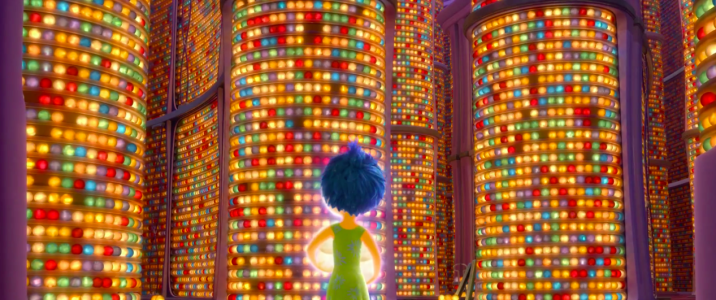The team at Pixar have taken advantage of the medium of animation in the past to produce a plethora of colorful environments and imaginative dreamscapes, but perhaps not quite to the extent or scope of their latest film Inside Out, a brainy (no pun intended) deconstruction of a child’s mind that is ostensibly for children to comprehend, if only on a basic level. The studio has been praised in the past for their innovative approach to storytelling and visual flights of fancy, which I have been admittedly prickly about. Yes, the team that has been producing computer-animated feature films for two decades have crafted some truly gorgeous parables, yet more often than not they have prohibited themselves from doing something truly unpredictable by attempting to cater to a young mainstream audience. At best, their finest concepts run out of steam and inevitably succumb to unneeded cliches, and at worst are fairly blatant forgeries of other tropes and outright films (I still have no idea how the creators of Doc Hollywood never took advantage of suing Disney for Cars). That being said, Inside Out is a wholly delightful surprise.
Its chief characters comprise of five emotions, all voiced by recognizable comedians. Joy (Amy Poehler) is the ebullient leader of the cerebral group that take it upon themselves to monitor the daily activities of 11-year old Riley. Her (it’s odd designating genders to emotions) compatriots are Sadness (Phyllis Smith), Fear (Bill Hader), Anger (Lewis Black, reigning in his profane persona), and Disgust (Mindy Kaling), and they all operate in a form of equilibrium until Riley and her parents move from their home in Minneapolis to San Francisco. This startling development perturbs the team, but Joy remains stubbornly optimistic that they can persevere through this brief crisis. Needless to say that this fool-proof scheme is complicated by a series of mishaps that ultimately expel Joy and Sadness, as well as some of Riley’s core memories, out of the control room and leave their colleagues scrambling to sustain Riley’s emotional stability. You can guess how well that goes.
I will be careful to divulge in what follows less to spoil the machinations of the plot but more to spare revealing to you some of the surprises director Pete Doctor and his team have in store for you. I will mention that they concern the subconscious, a truly bizarre venture into abstract thought, a dream that becomes downright Lynchian, and an imaginary friend named Bing Bong (Richard Kind) who is a combination of comestible and companion. Several of these set pieces are truly inspired and yield a bevy of charm in witnessing what the animators can craft utilizing the set of guidelines dictated by the clever script. The actual outcome of the story as well as the dynamic between Joy and Sadness is neither unexpected nor unusual, particularly the latter as it recalls several mismatched duos from previous Pixar classics such as Toy Story or Finding Nemo. Even Riley’s arc is simple, albeit by design, and it’s immensely refreshing to finally see a Pixar film without an obligatory antagonist present.
It’s this complex set of rules intermingled with a straightforward scenario that should spell disaster, yet Doctor, whose previous entries for the studio include Monsters, Inc. and the stupendous Up, manages to craft a film that includes jokes that cater to familiar tropes (the inner emotions of Riley’s parents certainly don’t dispel any gender stereotypes) whilst sneakily injecting enough verve into the proceedings that he can’t be accused of laziness. For example, one may question why Riley’s emotions are both male and female while every other character’s emotions conform fully to their gender. It is never directly addressed, nor does it need to be. It is simply one small detail in a film rife with them that lends this micro-universe a degree of delight and wonder.
However, the overwhelming emotion that adults may take away from Inside Out is one of melancholia. Themes of loss have been prevalent in Pixar’s output, and their latest is no exception to this. Yet not since Spike Jonze’sWhere the Wild Things Are has a mainstream family film attempted to convey the emotional tumult of being a child in a state of flux so directly, and indeed that may leave some of the youngest audience members confused. But like Jonze’s cult classic, it isn’t intended for mass consumption from the toddler demographic. Rather, it seeks to instill a nugget of empathy within anybody who has experienced a seismic shift in their seemingly staid existence and the resulting confusion of such a transition. That it conveys this difficult truth while supplying a generous helping of compassion and invention makes it a cause of celebration for pop art in American Cinema. What’s not there to be happy about?
